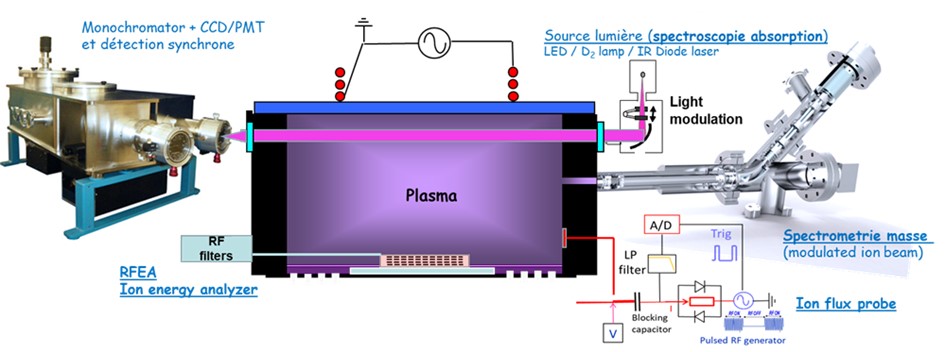- Share
- Share on Facebook
- Share on X
- Share on LinkedIn
In the last 20 years we have developed and implement sophisticated plasma diagnostics to assist the development of plasma etching processes. These diagnostics aims to measure the fluxes and energy (or temperature) of the plasma radicals and ions that are responsible for surface modifications in plasma processes and most of them are adapted to probed pulsed plasmas with a time resolution of 1 µs. Diode laser absorption spectroscopy is used to measure the doppler profile of Ar* metastable atoms and deduce the gas temperature. The absolute density of many important radicals (CFx, BClx, SiClx… etc) is measured by broad band UV absorption spectroscopy and we have introduced specific light sources for this purpose (UV-LED). Several stable molecules (NH3, NF3, HF, HBr…etc) are detected by VUV absorption spectroscopy in the 120 nm – 200 nm spectral range and some atomic species (Cl, Br …) are detected by modulated ion beam threshold ionization mass spectrometry. Finally, the ion energy distribution function is measured with commercial RFEA analyzers while the time variations of the ion fluxes is captured by a homemade capacitively-coupled planar probe. Thanks to those developments, we are able to measure the time variations of the most important species involved in pulsed plasma processes. This approach has proven to be particularly useful to develop innovative processes and new types of plasma reactors.

Fig.1: Plasma diagnostics installed on our 300mm reactor: modulated beam mass spectrometry (detection of radicals including atoms), VUV absorption spectroscopy (detection of radicals and stable molecules), capacitively coupled ion flux probe (ion flux) and RFEA multi-grid analyzers (measurement of the ions energy distribution function IVDF on the substrate). All these diagnostics are time-resolved (typical resolution of 10 µs).

Fig.2: a) Ion flux versus time in a pulsed ICP plasma at 1 kHz and for duty cycles of 10% to 75%. b) temporal variations of plasma density and electron temperature in the pulse. c) temporal variations of Cl and Cl2 densities in a pulsed plasma. In all cases, the experimental results are in good agreement with the modeling.
- Share
- Share on Facebook
- Share on X
- Share on LinkedIn